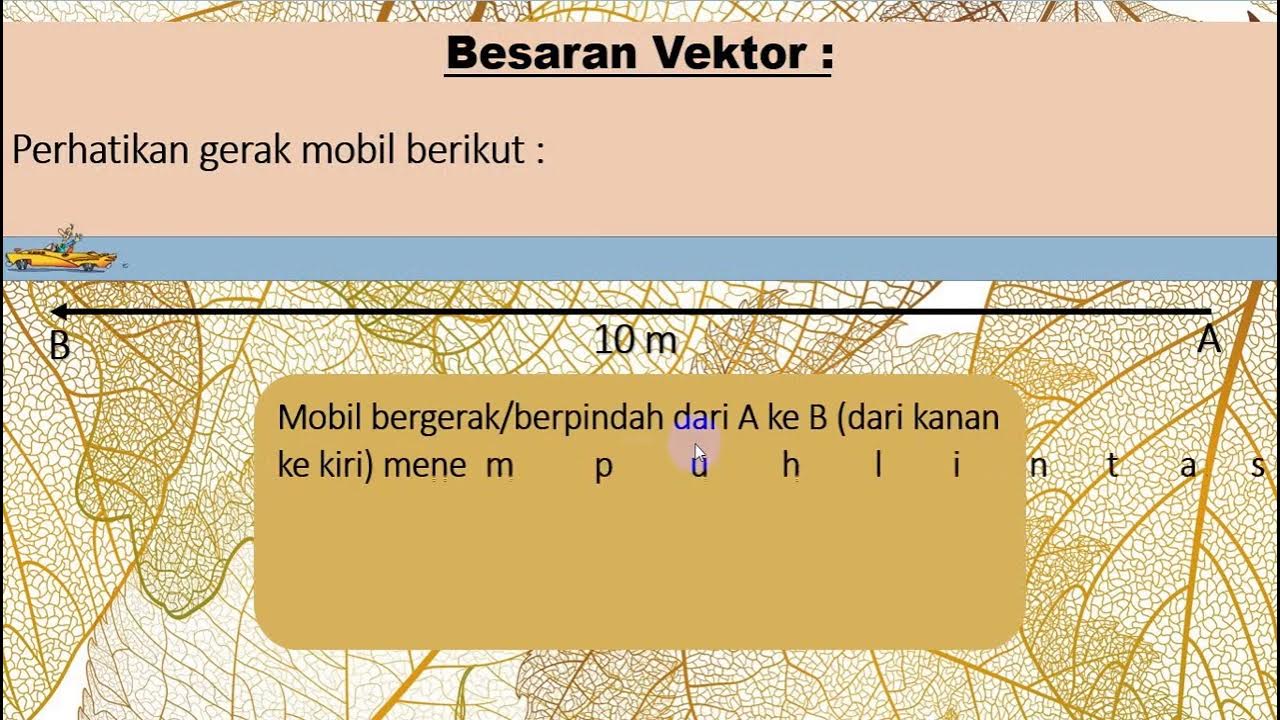GRANDEZAS FÍSICAS (ESCALARES E VETORIAIS) | Resumo de Física Enem. |Prof Marcus Rossetto
Summary
TLDRIn this video, the professor introduces the concept of physical quantities, distinguishing between scalar and vector quantities. He explains that scalar quantities, like time and mass, only require a numerical value and unit of measurement, while vector quantities, like force and velocity, need direction and sense as well. He goes on to describe common vector directions (vertical and horizontal) and the importance of specifying direction and sense when dealing with these quantities. Through examples like speed, pressure, and displacement, he clarifies how to differentiate between scalar and vector quantities, emphasizing their application in real-world scenarios like mechanics.
Takeaways
- 😀 Physical quantities can be measured and compared to a standard, such as distance, speed, acceleration, force, time, and mass.
- 😀 Love, emotions, and feelings cannot be quantified as physical quantities because they can't be measured.
- 😀 A scalar quantity is described by its magnitude alone, without needing additional information like direction or sense (e.g., time).
- 😀 A vector quantity requires both magnitude and direction (e.g., displacement, force).
- 😀 Direction refers to the line or segment of the straight path, and sense refers to the orientation of the vector (up, down, left, right).
- 😀 Examples of scalar quantities include time and mass, while vector quantities include force and displacement.
- 😀 Force can be described as a vector, with specific direction and sense (e.g., force applied to the right).
- 😀 When discussing vectors, it’s important to distinguish between direction (vertical or horizontal) and sense (up, down, left, right).
- 😀 Pressure is a scalar quantity, though force, which generates pressure, is a vector quantity.
- 😀 For displacement, speed, and acceleration, if the direction and sense are specified, they are considered vector quantities.
- 😀 A helpful trick in physics is to ask, 'Where to?' If there is no answer, the quantity is scalar; if there is, it is vector.
Q & A
What is a physical quantity, and how can it be classified?
-A physical quantity is anything that can be measured and compared with a standard. Examples include distance, velocity, acceleration, force, time, and mass. Physical quantities can be classified into two types: scalar and vector quantities.
What is the difference between scalar and vector quantities?
-Scalar quantities are defined only by their magnitude (numerical value and units), like time or mass. Vector quantities, on the other hand, require magnitude, direction, and sense, such as velocity or force.
Can you give an example of a scalar quantity?
-An example of a scalar quantity is time. For instance, if it's 9:00 AM, the time is just a magnitude, with no direction or sense associated with it.
What does a vector quantity need to be fully defined?
-A vector quantity needs three components to be fully defined: magnitude (size), direction (path), and sense (orientation).
What is an example of a vector quantity?
-An example of a vector quantity is force. If a force of 10 newtons is applied to an object, the direction and sense (e.g., to the right) must also be specified.
What does direction mean in the context of vector quantities?
-Direction refers to the path along which a vector acts. It can be horizontal, vertical, or inclined. In simple terms, it tells you which way the force, velocity, or any other vector quantity is acting.
What is meant by 'sense' when talking about vectors?
-Sense refers to the orientation or way a vector acts within a given direction. For example, if the direction is vertical, the sense can be either upwards or downwards.
Can you explain the confusion people have with direction and sense?
-People often confuse direction with sense. Direction is the path (e.g., horizontal or vertical), while sense indicates the orientation along that path (e.g., upwards or downwards for vertical direction).
Why is pressure considered a scalar quantity, even though it relates to force?
-Pressure is a scalar quantity because it is only defined by its magnitude, which is force per unit area. It does not require direction or sense, unlike force, which is a vector.
How can you distinguish between a scalar and vector quantity based on their real-world applications?
-If a physical quantity describes how much of something exists without any reference to direction or orientation, it is a scalar. If it describes how something moves or changes in a specific direction, it is a vector. For example, distance is scalar, but displacement is vector.
Outlines

This section is available to paid users only. Please upgrade to access this part.
Upgrade NowMindmap

This section is available to paid users only. Please upgrade to access this part.
Upgrade NowKeywords

This section is available to paid users only. Please upgrade to access this part.
Upgrade NowHighlights

This section is available to paid users only. Please upgrade to access this part.
Upgrade NowTranscripts

This section is available to paid users only. Please upgrade to access this part.
Upgrade NowBrowse More Related Video

Introdução ao Estudo da Física e Grandezas | Física - aula #1 | prof. Yuri Alves | Extensivo NPAC

Sistema Internacional de Unidades (SI) - Brasil Escola

Besaran vektor dan besaran skalar (Fisika SMA/MA Sagufindo kls X smt 1 : Vektor)

GCSE Physics Revision "Scalar and Vector Quantities"

Grandezas e Unidades

Vectors - Basic Introduction - Physics
5.0 / 5 (0 votes)